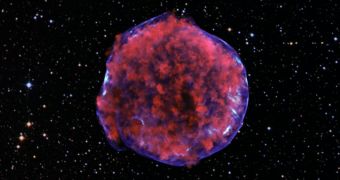According to scientists from the Harvard-Smithsonian Center for Astrophysics (CfA), it would appear that Type Ia supernovae can arise from two independent mechanisms. Until now, astronomers believed that these objects could only be created through a single process, and debated what that process was.
Over the years, experts created two competing models to explain the origins of Type Ia supernovae, and each explanation is supported by several studies. Now, CfA scientists have obtained evidences that both past models are correct, and that these objects can indeed occur from two different sources.
Studying Type Ia supernovae is extremely important for astronomy and astrophysics, because these exploded stars are used as standard candles to measure distances in the Universe. Their luminosity stays constant, and this allowed experts to discover dark energy, and to learn more about the Cosmos.
It was based on studying these structures that astronomers demonstrated the ever-accelerated expansion of the Universe, a discovery for which the team was acknowledged with the 2011 Nobel Prize in Physics.
“Previous studies have produced conflicting results. The conflict disappears if both types of explosion are happening,” CfA astronomer and Clay Fellow, Ryan Foley, says. He explains that all Type Ia supernovae are produced from the cores of old, helium-burning stars called white dwarfs.
Researchers found that these stars either have a gas envelope around them, or do not. One model suggests that the gas should be present, whereas the other holds that it shouldn't. The trick here is that white dwarfs that go Type Ia supernovae are located in binary systems – they have a companion.
“Just like mineral water can be with or without gas, so can supernovae,” explains the Harvard Clowes professor of astronomy, Robert Kirshner, who was also a coauthor on the new study. He says that the discovery has important implications for calculating cosmic distances and expansion rates.
“There are definitely two kinds of environments – with and without outflows of gas. Both are found around Type Ia supernovae,” Foley argues, based on a new study of 23 objects in this class.
He goes on to say that different origins for these events imply that different formulas need to be employed when calculating distances and expansion rates based on them.
“It's like measuring the universe with a mix of yardsticks and meter sticks - you'll get about the same answer, but not quite. To get an accurate answer, you need to separate the yardsticks from the meter sticks,” Foley concludes.

 14 DAY TRIAL //
14 DAY TRIAL //